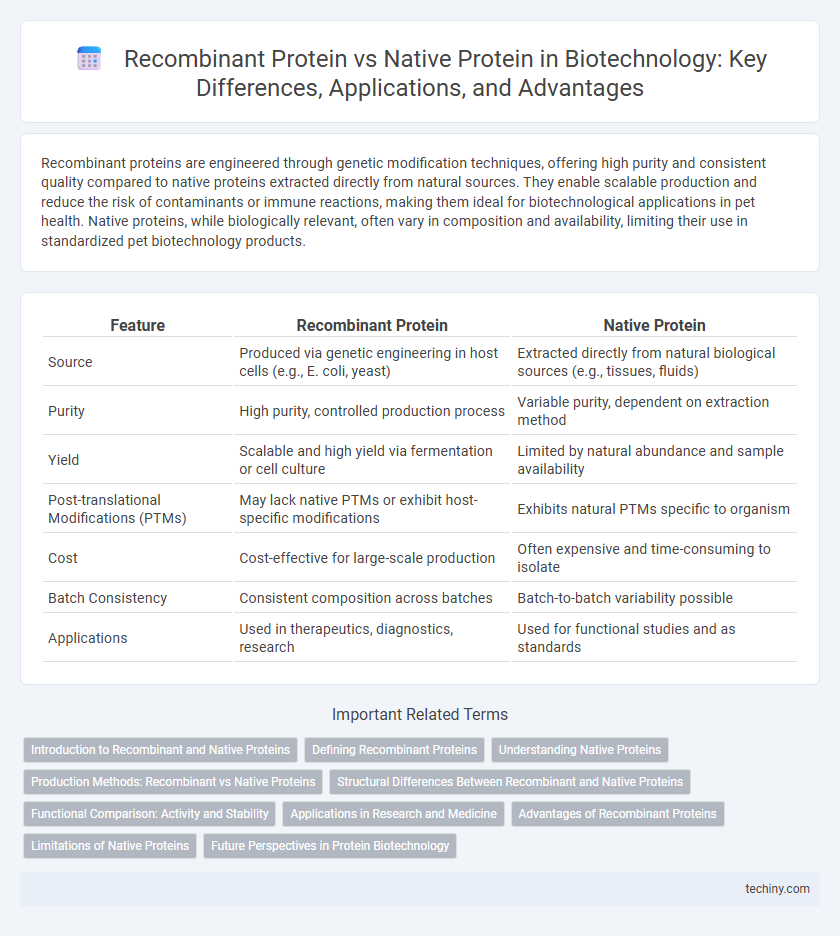Recombinant proteins are engineered through genetic modification techniques, offering high purity and consistent quality compared to native proteins extracted directly from natural sources. They enable scalable production and reduce the risk of contaminants or immune reactions, making them ideal for biotechnological applications in pet health. Native proteins, while biologically relevant, often vary in composition and availability, limiting their use in standardized pet biotechnology products.
Table of Comparison
| Feature | Recombinant Protein | Native Protein |
|---|---|---|
| Source | Produced via genetic engineering in host cells (e.g., E. coli, yeast) | Extracted directly from natural biological sources (e.g., tissues, fluids) |
| Purity | High purity, controlled production process | Variable purity, dependent on extraction method |
| Yield | Scalable and high yield via fermentation or cell culture | Limited by natural abundance and sample availability |
| Post-translational Modifications (PTMs) | May lack native PTMs or exhibit host-specific modifications | Exhibits natural PTMs specific to organism |
| Cost | Cost-effective for large-scale production | Often expensive and time-consuming to isolate |
| Batch Consistency | Consistent composition across batches | Batch-to-batch variability possible |
| Applications | Used in therapeutics, diagnostics, research | Used for functional studies and as standards |
Introduction to Recombinant and Native Proteins
Recombinant proteins are artificially synthesized through genetic engineering by inserting specific DNA sequences into host cells, allowing large-scale production of targeted proteins with high purity. Native proteins, naturally occurring in organisms, maintain their original conformation and post-translational modifications, crucial for their biological activity and functionality. Understanding the structural and functional differences between recombinant and native proteins is essential for applications in drug development, diagnostics, and therapeutic interventions in biotechnology.
Defining Recombinant Proteins
Recombinant proteins are engineered in biotechnology by inserting specific genes into host cells such as bacteria, yeast, or mammalian cells to produce proteins that mimic native proteins structurally and functionally. Unlike native proteins extracted directly from organisms, recombinant proteins offer higher purity, scalability, and reduced risk of contaminants, enabling precise therapeutic and industrial applications. The production process involves gene cloning, expression, and purification, ensuring targeted protein yield tailored to research or pharmaceutical needs.
Understanding Native Proteins
Native proteins exhibit their natural conformation and biological activity as found in living organisms, making them essential for studying physiological functions and protein interactions. These proteins undergo post-translational modifications, such as glycosylation and phosphorylation, which are critical for maintaining structural stability and functional specificity. Understanding native proteins provides a benchmark for evaluating the accuracy and efficacy of recombinant protein production in biotechnological applications.
Production Methods: Recombinant vs Native Proteins
Recombinant protein production utilizes genetically engineered host cells such as bacteria, yeast, or mammalian cells to express target proteins with high yield and scalability, enabling precise control over protein modifications. Native protein production involves extraction and purification directly from natural biological sources, often resulting in limited quantities and variability due to physiological conditions. Recombinant methods offer advantages in consistency and customization, while native protein extraction maintains the original post-translational modifications inherent to the source organism.
Structural Differences Between Recombinant and Native Proteins
Recombinant proteins often exhibit structural variations compared to native proteins due to differences in post-translational modifications, folding patterns, and expression systems used in biotechnology. Variability in glycosylation, phosphorylation, and disulfide bond formation can alter the stability, solubility, and biological activity of recombinant proteins relative to their native counterparts. These structural discrepancies impact protein functionality and must be carefully characterized during drug development and therapeutic applications.
Functional Comparison: Activity and Stability
Recombinant proteins often exhibit enhanced functional activity due to optimized expression systems and purification methods, allowing for precise modifications that improve binding affinity and enzymatic efficiency. Native proteins maintain their natural post-translational modifications and conformational stability, which can provide superior structural integrity and interaction specificity under physiological conditions. Stability of recombinant proteins may vary depending on host organism and expression conditions, sometimes requiring additional stabilization strategies to match the native protein's resilience in vivo.
Applications in Research and Medicine
Recombinant proteins offer precise control over expression and modification, making them essential for developing targeted therapies and diagnostic tools in medicine. Native proteins, derived directly from organisms, provide critical insights into natural biological functions and serve as benchmarks for functional assays in research. The use of recombinant proteins accelerates drug discovery and vaccine development by enabling scalable production and enhanced purity compared to native proteins extracted from complex biological sources.
Advantages of Recombinant Proteins
Recombinant proteins offer enhanced purity and consistency compared to native proteins, reducing the risk of contamination from other cellular components. They enable large-scale production with precise control over protein modifications, facilitating tailored therapeutic and industrial applications. Their ability to be produced in various host systems ensures scalability and cost-effectiveness, meeting high demand in research and pharmaceutical manufacturing.
Limitations of Native Proteins
Native proteins often exhibit limited stability, narrow availability, and batch-to-batch variability, which hinder their application in research and therapeutics. Their extraction from natural sources can result in impurities and inconsistent post-translational modifications, impacting protein functionality. Recombinant proteins address these limitations by enabling controlled, scalable production with customizable features and enhanced consistency.
Future Perspectives in Protein Biotechnology
Future perspectives in protein biotechnology emphasize the expanding potential of recombinant proteins due to their scalability, molecular customization, and enhanced functional properties compared to native proteins. Advances in gene editing, synthetic biology, and high-throughput screening enable precise design and production of recombinant proteins with improved stability, activity, and therapeutic efficacy. Innovations in expression systems and bioprocessing technologies promise to overcome current limitations, facilitating cost-effective manufacturing and personalized medicine applications.
Recombinant protein vs Native protein Infographic

 techiny.com
techiny.com